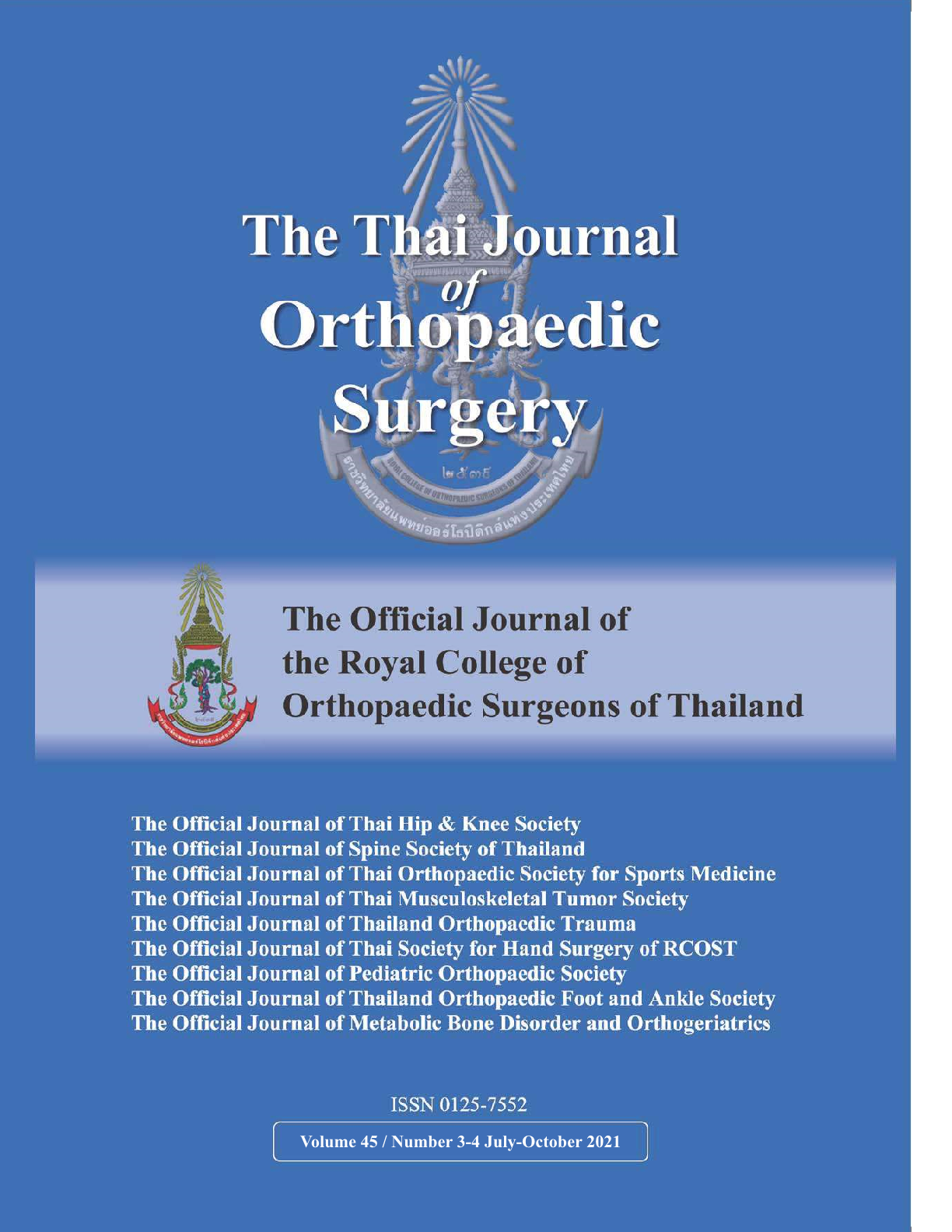Functional and Results from Nail Lengthening with the Eponychial Folding Procedure Reconstruction of the Fingertip Amputation
Main Article Content
Abstract
Purpose: Fingertip amputation usually involved soft tissue, bone, and nail. Various local flaps reconstruct only soft tissue volar pulp dose not restore nail length after fingertip amputation. To overcome this problem “The Eponychial Folding Procedure” lengthens the nail plate and restore a good appearance of the nail apparatus was employed. The purposes of this study were present the outcomes of nail salvage by Eponychial Folding Procedure combined with several local flaps following fingertip amputation.
Methods: In the period between January 2018 and October 2019 at Samutsakorn Hospital. 30 cases of fingertip amputation with nail bed defects underwent pulp reconstruction with different local flaps depending on the geometry of the amputated digit tip. We increased nail bed exposure by creating 4-6 mm parallel incision at distal eponychium. The eponychium flap was elevated then fold proximally to expose more nail matrix, thereby effectively lengthening the exposed nail bed. The outcomes for fingertip appearance, nail length, and nail bed area at pre and postoperative treatment were evaluated. The finger’s range of motion (ROM) was compared to the contralateral uninjured fingers as control. The paired t test was employed for α<.05 considered statistically significant
Results: There were 25 patients (5 patients were affected 2 fingers) with mean age of 31 (18-51 years). The procedures were performed initial injury and secondary treatment after consequence previous operation, neither pulp reconstruction nor eponychial flap loss occurred. The visible nail increased 5.78 mm (4-7mm), nail bed area was enlarged 60% (25-150%). All patients were satisfied with the appearance and function of the reconstructed fingertips.
Conclusions: Fingertip amputation with nail bed involvement should be reconstructed not only volar soft tissue but considered the nail as well. Eponychial folding Procedure combined with different local flaps provided for the aesthetic and functional restoration of the fingertip amputation, both initial injury and its consequence.
Article Details
References
2. Peterson SL, Peterson EL, Wheatley MJ. Management of fingertip amputations. J Hand Surg Am. 2014; 39(10): 2093-101.
3. Koh SH, You Y, Kim YW, Kim JS, Lee DC, Roh SY, et al. Long-term outcomes of nail bed reconstruction. Arch Plast Surg. 2019; 46(6): 580-8.
4. Kang DH, Nam HJ, Cheon HJ, Kim YW, Woo SH. Immediate nail lengthening with the eponychial folding Procedure in acute fingertip injury. J Korean Soc Surg Hand. 2017; 22(1): 27-33.
5. Allen MJ. Conservative management of fingertip injuries in adults. Hand. 1980; 12(3): 257-65.
6. Panattoni JB, De Ona IR, Ahmed MM. Reconstruction of fingertip injuries: surgical tips and avoiding complications. J Hand Surg Am. 2015: 40(5): 1016-24.
7. Chen SY, Wang CH, Fu JP, Chang SC, Chen SG. Composite grafting for traumatic fingertip amputation in adults: technique reinforcement and experience in 31 digits. J Trauma. 2011; 70(1): 148-53.
8. Atasoy E, Ioakimidis E, Kasdan ML, Kutz JE, Kleinert HE. Reconstruction of the amputated fingertip with a triangular volar flap. A new surgical procedure. J Bone Joint Surg Am. 1970; 52(5): 921-6.
9. Tsai TM, Yuen JC. A neurovascular island flap for volar-oblique fingertip amputations. Analysis of long-term results. J Hand Surg. 1996; 21B: 94-8.
10. Horta R, Nascimento R, Monteiro D, Silva A, Amarante JS. The reverse homodigital flap based on the dorsal branch of the digital artery for reconstruction of acquired clinodactyly. J Hand Microsurg. 2016; 8(1): 57-8
11. Nishikawa H, Smith PJ. The recovery of sensation and function after cross-finger flaps for fingertip injury. J Hand Surg. 1992; 17B: 102-7.
12. Melone CP, Beasley RW, Carstens JH. The thenar flap an analysis of its use in 150 cases. J Hand Surg. 1982; 7(3): 291-7.
13. Endo T, Nakayama Y. Microtransfers for nail and fingertip replacement. Hand Clin. 2002; 18(4): 615-22.
14. Zachary SV, Peimer CA. Salvaging the “unsalvageable” digit. Hand Clin. 1997; 13(2): 239-49.
15. Brown RE, Zook EG, Russell RC. Fingertip reconstruction with flaps and nail bed grafts. J Hand Surg Am. 1999; 24(2): 345-51.
16. Bakhach J. Eponychial flap. Ann Chir Plast Esthet. 1998; 43(3): 259-63.
17. Adani R, Marcoccio I, Tarallo L. Nail lengthening and fingertip amputations. Plast Reconstr Surg. 2003; 112(5): 1287-94.
18. Xing S, Shen Z, Jia W, Cai Y. Aesthetic and functional re¬sults from nailfold recession following fingertip amputa¬tions. J Hand Surg Am. 2015; 40(1): 1-7.
19. Nakanishi A, Omokawa S, Kawamura K, Iida A, Kaji D, Tanaka Y. Tamai zone 1 fingertip amputation: reconstruction using a digital artery flap compared with microsurgical replantation. J Hand Surg Am. 2019; 44(8): 655-61.


